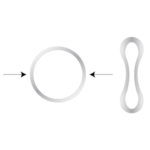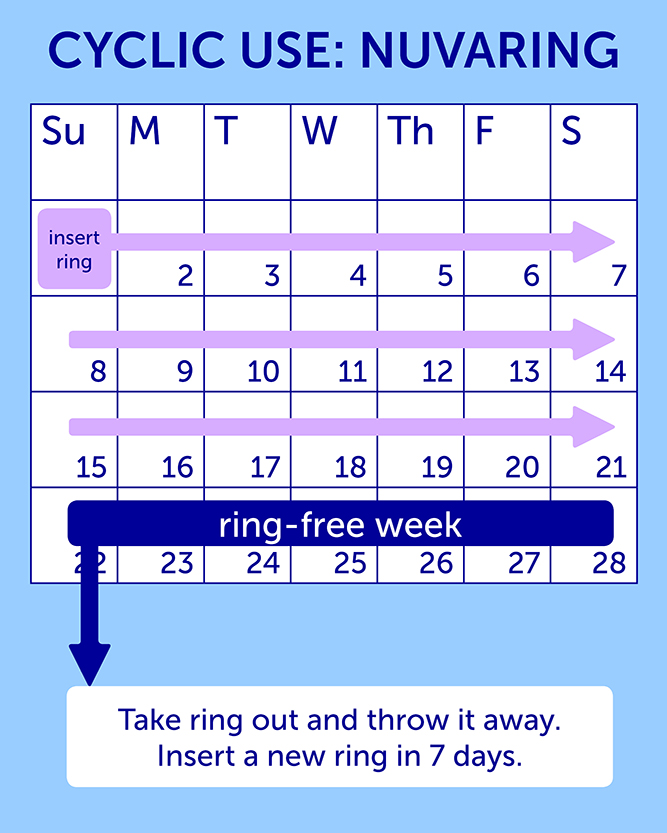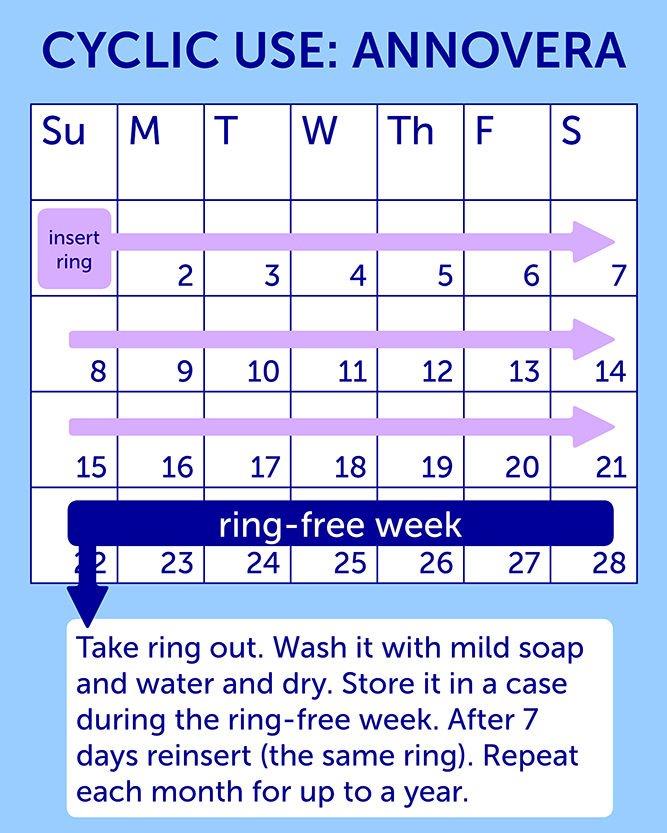Key Facts
- There are two types of vaginal hormonal rings approved by the FDA: NuvaRing® lasts for a month at a time, and Annovera™ lasts for a year (13 cycles).
- Both vaginal rings are effective in preventing pregnancy, if used correctly.
- The vaginal hormonal ring may also be prescribed for irregular periods, menstrual cramps, or endometriosis.
- The vaginal ring releases two hormones (estrogen and progesterone) to stop the ovaries from making eggs.

The vaginal ring is a method of birth control that provides both estrogen and progestin hormones. You need a prescription from your health care provider. The vaginal ring is also used to treat conditions such as irregular periods, menstrual cramps, or endometriosis.
What is the vaginal hormonal “ring”?
The vaginal hormonal ring is a method of birth control that contains estrogen and progestin, the same hormones that are in combination birth control pills. It is inserted into the vagina similar to a tampon.
How does the ring work?
There are two different hormones called estrogen and progestin in the vaginal ring. When the ring is inserted in a woman’s vagina, the medicine is released into the vagina and absorbed through the vaginal wall. The medicine then enters the bloodstream to stop the ovaries from releasing eggs. This medicine also makes the cervical mucus thicker, which helps to prevent sperm from traveling upwards towards the uterus and fallopian tubes.
Can teenagers use the ring?
Yes. The vaginal ring is easy to use and safe for most teens. The benefits include shorter, lighter, and less painful periods. Weight gain is uncommon and unlikely to be related to the ring. If you are thinking about using the “ring”, make sure to tell your health care provider if you have any medical problems such as blood clots, heart problems, high blood pressure, or severe migraine headaches with aura (such as flashing lights 5 to 30 minutes before the migraine).
Do I need a prescription for the ring?
Yes. You do need a prescription from your health care provider (HCP) to buy the ring, but you DON’T need to be fitted for it. One size fits all. It’s sold under the brand names NuvaRing® or Annovera™. Talk to your HCP to see if you can use hormone methods such as the ring. Cigarette smoking increases your risk for heart problems. If you smoke, work with your HCP to quit.
Is the ring as effective as the pill in preventing pregnancy?
Yes, when used correctly. The ring is 98-99% effective in preventing pregnancy. Some herbal medicines and antibiotics may lower the effectiveness of the vaginal hormonal ring. Be sure to tell your health care provider if you are taking any over-the-counter herbs or dietary supplements.
Do I need to use condoms when I’m using the ring?
Yes. The ring does NOT prevent sexually transmitted infections (STIs), so make sure you use condoms 100% of the time. The first cycle that you start using the ring, it may not be as effective in preventing pregnancy, so it’s especially important for you to use condoms the first 7 days.
How should I use the ring?
When you’ve had your questions answered and you have learned how to insert the ring, you’re ready to begin. Fill the prescription at your pharmacy. Like other hormonal methods, the ring can be used in a cyclic fashion with a week off or continuously with no time off between taking out one ring and putting in the next.
Nuvaring®

Annovera™

When should I begin using the ring for the first time?
You should begin using the ring by inserting it between Day 1 and Day 5 of your menstrual cycle. Day 1 of your cycle is the first day of your flow (bleeding). The ring should be inserted by cycle day 5 at the very latest, even if you still have your period. Your health care provider may also have you start using it right after your appointment (“quick start”) and use condoms for the first cycle.
How do I insert the ring?
- Before you begin, wash and dry your hands.
- With clean hands, gently open the foil pouch that the ring comes in. If using Nuvaring®, save the pouch so you can throw the used vaginal ring away when it’s time to change it.
- Make sure you find a private place such as your room or the bathroom, so you’ll feel relaxed.
- You may want to lie down in bed with knees bent or squat down with knees bent or stand with one leg on a chair or toilet seat. (It’s similar to inserting a tampon.)
- Using one hand (right hand if you are right-handed, left if you are left-handed), hold the vaginal ring between your thumb and index finger. Hold the sides together so they are touching and the ring is folded.
- While holding the ring, gently insert the ring into your vagina as far as it will go. (If you don’t want to touch your vagina to put it in, you can use a cardboard tampon container with the tampon removed. Simply take out the tampon and place the ring inside the empty container. Insert the container with the ring inside and push the applicator to insert the ring.)
Will I feel the ring?
The exact position of the ring is not important for it to be effective but it should be comfortable. Most teens and women who use the vaginal ring do not feel it once it is in place. If you do feel it, gently push the ring a little further back into the vagina. The ring should not hurt or cause discomfort once it is inserted and placed correctly. If it feels uncomfortable, remove it, read the “How do I insert the ring?” directions again, and then try to insert it once more. If you still can’t insert the ring without discomfort, stop and contact your health care provider.
If I push the ring too far up inside my vagina, will it get lost?
No. The ring can’t get lost inside of your vagina. Your cervix, which is located at the end of your vagina, prevents the ring from traveling up into your uterus.
How long do I leave the ring inside my vagina?
Once in place, the ring should stay inside your vagina for 3 complete weeks unless you are having problems such as new migraine headaches or severe nausea (feeling like you want to throw up most of the time).
NuvaRing® Use:
If you are using the NuvaRing®ring in a cyclic way, you will remove the ring after 3 complete weeks or 21 days and wait 1 full week before you insert a new ring. You will likely have a period during the ring-free week.
If your health care provider tells you to use the NuvaRing continuously you will remove the ring after 3 complete weeks and insert a new ring right away. You may only have spotting or no bleeding at all.
Annovera™ Ring Use:
If you are using the Annovera™ ring, you will take the ring out after 3 complete weeks or 21 days. You will wash the ring with mild soap and water, pat dry, put it in the case for 7 days, and then insert the same ring 1 week later.
Is it possible for the ring to fall out?
It’s possible but unlikely the ring will come out of your vagina. If the vaginal ring is inserted properly, the muscles inside your vagina hold the ring in place. The ring could possibly come out if it is not inserted high enough into your vagina, if you are very constipated, straining with a bowel movement, or it could slip out if you are removing a tampon. The ring is meant to be worn during sex.
What do I do if the ring slips out?
If you are using the NuvaRing® and the ring slips out of your vagina, it’s okay to gently rinse it under cold water (not hot water!) then re-insert the ring in your vagina as soon as possible. You must do this within 2-3 hours. If you wait longer than 3 hours or forget to put the ring back in your vagina, there’s a chance that the ring will not prevent pregnancy. If this happens, place the ring back in your vagina and use a “back up” method of contraception, such as condoms for 7 days.
If you are using the Annovera™ vaginal ring and it slips out of your vagina, wash it with mild soap and water, pat dry and then re-insert the ring in your vagina within 2 hours. If you wait longer than 2 hours or forget to put the ring back in your vagina, there’s a chance that the ring will not prevent pregnancy. If this happens, place the ring back in your vagina and use a “back up” method of contraception, such as condoms for 7 days.
Can I use tampons?
Yes. However, the ring may come out when the tampon is removed. Generally, you will not have your period during the 3 weeks while you have the ring in place. You will probably have your period during the “ring-free week” and you won’t have to worry about using a tampon at that time. If the ring slips out, follow the above directions.
How do I take the vaginal hormonal ring out of my vagina?
Insert your index and middle finger of one of your hands into your vagina and gently feel for the ring. Once you feel the ring, hook your index finger around it and guide it out with your middle finger, pulling forward until the ring comes out. This should not hurt at all because the ring is thin and flexible. If you are using the NuvaRing®, you will change your ring every month. Once you have removed the ring, place it in the pouch that it came in, seal the pouch then throw it away in the trash-away from young children and pets. If you forget to save the pouch, either wrap the ring in a piece of aluminum foil or place it in a small, sealed plastic bag. NEVER flush the ring down the toilet!
Do I need to take the ring out on the same day of the week that I put it in?
Yes, you should remove the ring on the same day of the week that you started. For example, if you inserted the ring on Sunday at 9:00 pm, you will need to remove the ring 3 full weeks later on a Sunday at about the same time, at 9:00 pm.
What if I forget to take the ring out?
NuvaRing® Use: If you are using the ring in a cyclic way (3 weeks on, 1 week off) and you leave the ring in for up to 4 weeks, remove the ring, throw it away, and wait 1 week before you insert a new ring.
If you are using the ring in a continuous way, and you leave the ring in for up to 4 weeks, remove the ring, throw it away, and insert a new ring.
If you are LESS than 48 hrs. late with inserting a new ring and you are sexually active:
- Insert the ring as soon as possible
- Keep the ring in until the scheduled ring removal day.
- Emergency contraception (EC) is not usually needed but can be considered depending on day of your cycle. Talk to your health care provider HCP to find out if you should have a pregnancy test or if EC is needed.
If you are MORE than 48 hrs. late with inserting a new ring and you are sexually active:
- Insert the new ring as soon as possible
- Keep the ring in until the scheduled ring removal day.
- Use back-up contraception (condoms) or avoid sexual intercourse until a ring has been worn for 7 straight days.
- Talk to your health care provider about whether you should take Emergency Contraception (EC). Let your HCP know the week of your menstrual cycle.
Annovera™Use: If you are using the Annovera ring in a cyclic fashion and you forget to take it out after 3 weeks:
- Remove the ring, wash it, dry it, put it in the case, and reinsert it in 1 week
Can I have sex while I am wearing the ring and will my partner be able to tell?
Having intercourse is a personal decision. The ring is safe and should stay in the vagina during intercourse. Your partner won’t usually be able to feel the ring. If the ring is a problem during intercourse, then the ring can be removed for up to 2 hours. A diaphragm (another form of birth control) is not meant to be used with the vaginal hormonal ring. Always use condoms when having sexual intercourse to lower your risk of getting a sexually transmitted infection (STI).
Are there any side effects with the ring?
Side effects are uncommon; but are similar to the side effects of oral contraceptive pill as it contains the same hormones (progestin and estrogen). Occasionally women report headaches, nausea, and breast tenderness. Other, less common side effects may include vaginal irritation, yeast infection, and/or urinary tract infection.
Are there any reasons why I shouldn’t use the ring?
The ring contains the same medicine that is in birth control pills, the hormones estrogen and progestin, so it may not be safe for you to use if you have a history of certain medical problems such as blood clots, high blood pressure, or serious migraine headaches. It’s very important to tell your health care provider if you or other close family members have a history of any of these conditions. Cigarette smoking greatly increases your risk for serious cardiovascular conditions, while quitting smoking will make you healthier and using the ring safer.
Is there anything else I should know about the vaginal hormonal ring?
Progering®is a progesterone-only releasing hormonal ring that has been approved for breastfeeding mothers. At this time the new Progering® is only available in certain areas of Latin America.
For more information, visit nuvaring.com.
Parts of this guide were adapted from the patient handout, The First Contraceptive Vaginal Ring-NuvaRing. (Organon)
Our health guides are developed through a systematic, rigorous process to ensure accuracy, reliability, and trustworthiness. Written and reviewed by experienced healthcare clinicians from Boston Children's Hospital, a Harvard Medical School teaching hospital and consistently ranked as a top hospital by Newsweek and U.S. News & World Report, these guides combine clinical expertise, specialized knowledge, and evidence-based medicine. We also incorporate research and best practices from authoritative sources such as the CDC, NIH, PubMed, top medical journals, and UpToDate.com. Clinical specialists and subject matter experts review and edit each guide, reinforcing our commitment to high-quality, factual, scientifically accurate health information for young people.